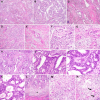Clinicopathological and Molecular Differences Between Gastric-type Mucinous Carcinoma and Usual-type Endocervical Adenocarcinoma of the Uterine Cervix
- PMID: 32859641
- PMCID: PMC7472441
- DOI: 10.21873/cgp.20219
Clinicopathological and Molecular Differences Between Gastric-type Mucinous Carcinoma and Usual-type Endocervical Adenocarcinoma of the Uterine Cervix
Abstract
Background/aim: We investigated differences in the clinicopathological and molecular characteristics between gastric-type mucinous carcinoma (GMC) and usual-type endocervical adenocarcinoma (UEA).
Patients and methods: We collected the clinicopathological information and performed targeted genomic sequencing analysis.
Results: GMCs exhibited significantly deeper invasion depth, larger horizontal spread, more advanced stage, more frequent distant metastasis, and more frequent parametrial and vaginal extension. Disease-free survival time of GMC patients was significantly shorter than that of UEA patients. GMCs displayed mutant p53 immunostaining pattern, whereas UEAs exhibited p16 block positivity. GMCs harbored mutations in KRAS, TP53, NF1, CDKN2A, STK11, and ARID1A. One GMC exhibited MDM2 amplification. In contrast, UEAs harbored mutations in HRAS, PIK3CA, and BRCA2. Two UEAs were found to have novel TP53 mutations.
Conclusion: GMC is associated with more aggressive behavior than UEA. Distinctive p53 and p16 immunostaining patterns enable differential diagnosis. GMC and UEA exhibit genetic heterogeneity with potentially actionable molecular alterations.
Keywords: Uterus; cervix; gastric-type mucinous carcinoma; immunohistochemistry; targeted sequencing; usual-type endocervical adenocarcinoma.
Copyright© 2020, International Institute of Anticancer Research (Dr. George J. Delinasios), All rights reserved.
Conflict of interest statement
The Authors have no conflicts of interest to declare regarding the study.
Figures





References
-
- Kurman RJ, Carcangiu ML, Herrington S, Young RH. IARC. 2014. WHO classification of tumours of female reproductive organs.
-
- Mathew A, George PS. Trends in incidence and mortality rates of squamous cell carcinoma and adenocarcinoma of cervix—worldwide. Asian Pac J Cancer Prev. 2009;10:645–650. - PubMed
MeSH terms
Substances
LinkOut - more resources
Full Text Sources
Medical
Research Materials
Miscellaneous
